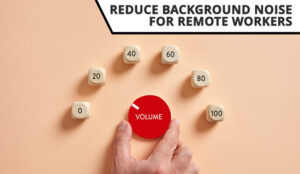Background noise is a real problem in many call centres. The noise is transmitted down the phone to the customer and your agents can find it difficult to think. So what possible solutions are available?
1. Reduce staffing density
One of the most effective but expensive options is to reduce the density that people are packed into the contact centre. Ideally you should have over 120 square feet per agent.
This should give people more room to breathe and make the call centre a more relaxed environment.
For ideas on reducing background noise during read calls, read our article: How to Reduce Background Noise During a Call – With Remote-Working Ideas
2. Treat the call centre like a library
The quietest call centre that I ever visited was at Sun Microsystems about ten years ago. Their call centre (for high-end server support) felt more like a library.
On the tour we were asked to keep silent or speak softly (almost in whispers). “Our support experts need it to be quiet to be able concentrate on solving our clients’ technical problems.” – How refreshing!
3. White noise machines
You can install white noise generators which help create artificial levels of background noise and mask the more obtrusive sounds that can distract or make it difficult to hear what is being said.
“This enables staff to hear customers more clearly without being distracted by the general sounds of everyday call centre hustle and bustle,” explains Richard Kenny of Plantronics.
Miguel Barcena, an experienced call centre manager is an advocate of this technique: “I use this white noise and it really helps to concentrate on your own voice and avoids the customer listening to all the noise”.
Echo cancelling devices can also be installed.
4. Go back to having cubicles
Taking down the partitions can result in an open-plan look and feel, it also makes the background noise increase. Cubicles provide good acoustic baffles, as well as providing a degree of privacy.
Noise-reducing foam can be installed with each cubicle and increasing the distance between the siting of agents definitely helps reduce the noise level.
5. Put all noisy machines in another room
Sitting in front of a photocopier or fax machine that is constantly beeping to inform you it is out of paper would certainly irritate even the calmest individual. The same could be said about the coffee or vending machine.
So think about your call centre layout. Consider placing all office appliances at the back of the office or in another room so no one can hear these irritating and loud sounds.
6. Don’t hold your meetings on the call centre floor
Separation is also good in the call centre environment so it’s a good idea to establish separate boardrooms for all team meetings, both serious and ad hoc.
As Andrew Doyle at Jabra comments: “It seems that unnecessary chatting between employees as they meet in the hallway can really irritate others on the telephone, so take all conversations into another room.”
7. Soft and silent
Bouncing sound waves off hard walls and wooden floors will raise the sound levels in your office by a significant amount. Replace wood flooring with carpet and introduce some plants to help absorb ambient noise.
Call centres can also reduce background noise by adding sound-absorbing material between agents or on floors and walls. This can lessen the impact of neighbouring conversations on their ability to hear customers.
You can use soft panels in the furniture, heavy duty carpets, blinds and ceiling absorber panels.
8. Use office plants
Using large plants in the office can help to deflect noise. The Yucca and the Cheese Plant spring to mind, but be careful not to make the call centre look like it is trapped in the 1980s.
Make sure that you have someone to water the plants.
9. Use a two-ear headset
Call centres are really busy and noisy environments and constantly being on the phone can be quite difficult as you can hear what is being said around you. A duo (binaural) headset is particularly good as it reduces background noise and ensures a crystal clear conversation. When using a duo headset, sound is directed into both ears of a user on the telephone. Employees are fully focused on calls and will not try and speak even louder in order to hear the person on the other end.
10. Use noise-cancelling headsets
Headset technology has developed significantly over the last few years, incorporating noise-cancelling and wireless capabilities, which can be invaluable in the call centre.
But the type of headset is also quite important. “If you feel more comfortable with a headset in one ear then at least ensure that you get a headset with noise cancelling ability,” says Andrew Doyle. Noise cancelling filters out background noise from your environment so the customer gets an improved audio experience but the additional effect is that the general noise level in your office or contact centre environment will be lower.
“Noise-cancelling technology significantly reduces background noise, allowing for clean and crisp communication between the agent and customer,” explains Richard Kenny from Plantronics.
11. Ban mobile phones
Personal phones can also be a noisy nuisance. A mobile phone ringing on a desk while the owner is out at lunch or in the boardroom in a long meeting could lead to a mobile phone through the office window! Implement a policy that ensures all employees switch their phones off if they are away from their desk for some time and concentration levels should rise.
12. Remember the Noise at Work Act
And don’t forget legal obligations too. Brought into effect in April 2006, the Noise at Work regulation aims to protect employees’ hearing in an office environment. The law stipulates that employers must implement safety measures to keep daily average sound exposure below 85dB for their employees, so it is important to ensure changes are made for a productive and healthy workforce.
Occasionally call centre operators experience unwanted and unexpected noise such as a sudden loud shriek or a piercing tone through their headsets. Where these cause symptoms like a startle reflex, tingling, dizziness, nausea, headaches, fullness of hearing or tinnitus, the operator has experienced an acoustic shock or startle.
The sounds originate either from line faults, misdirected faxes, power supply failures or, in some instance, are man-made. Despite these sounds seldom being loud enough to cause physical damage to the ear drum, the effects on the operator can be quite severe and range from simple annoyance to, in some cases, incapacity to continue work.
I would like to thank the following contributors for their input:
- Miguel Barcena
- Richard Kenny, EMEA Contact Centre Business Marketing Manager, Plantronics
- Andrew Doyle, Sales Director at Jabra
Author: Jo Robinson
Published On: 9th Jun 2010 - Last modified: 14th Feb 2025
Read more about - Call Centre Management, CX, Headsets, Jabra, Poly, Richard Kenny, Staffing










































We installed a Voice Arrest Speech Privacy System in our call center. Works great!
Good points, like plants within the floor can reduce noice…though the space crunch is there, as the rent per Sqft rate is increasing day by day….
A great masking system supplier is LogiSon Acoustic Networks. Very flexible and scalable technology relative to others.
Good article with much useful info. In addition, the design of workstations can have a lot to do with attenuation of voices. We often use cubicles with glass forward of the user, and high levels of absorption around them, so that there is good daylight penetration and good acoustic control. We also have numerical standards in place for building performance (lighting, daylighting, acoustics, thermal comfort and indoor air quality), these perceptual comfort variables are measured before occupancy under a performance commissioning program.
It’s important to note that most masking systems are poorly designed (too few speakers) and incorrectly tuned. They run at too loud a perceived level and cause people to raise their voices. So a good system should be design by an acoustic consultant conversant with open plan acoustics and audio.
Steven Orfield
Orfield Laboratories, Inc.
I think these should really be put into practice. Another tip is to put a huge distance from the pantry. Pantry is the place where workers can talk about their calls so this might cause some noise in the floor.
What’s that shield like visor that fits behind a chair to keep a customer from hearing all the charter in the call center?